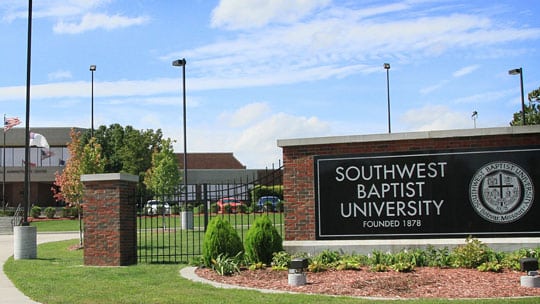In 2008, bivocational pastors led 7,894 of the 38,189 Southern Baptist Convention-affiliated churches that responded to the denomination’s Annual Church Profile. By 2012, the total had risen to 8,113 of only 36,390 that reported, according to LifeWay Research that manages ACP records.

Melissa Newberry (in front) poses with church members during a fellowship outing. The pastor of Grandview Baptist Church in Kansas City, Kan., loves spending time with members and works hard at balancing time. (Grandview Baptist Church photo)
|
Likely, the bivocational numbers — not just in Southern Baptist circles, but also across denominations — will increase. Five experts on bivocational ministry agree that economic issues may be the driving force, though other reasons are pushing the trend as well.
What is bivocational ministry? While many people, lay and full-time clergy alike, often view bivocational ministers or their churches as part-time, Ray Gilder, director of bivocational ministries for the Tennessee Baptist Convention and national coordinator of the SBC’s Bivocational and Small Church Leadership Network, takes exception to the characterization.
Bivocational ministers also are sometimes called tentmakers, based upon the Apostle Paul who often supported himself with his tent-making skills.
Bivocational means far more than simply holding two jobs. Vocation means calling, Gilder explains in his book, Uniquely Bivocational: Understanding the Life of a Pastor who has a Second Job. Preachers who serve bivocationally do so because they feel called to ministry, but for a variety of reasons — often by choice — they are pastors of churches that cannot support them. Churches that utilize bivocational ministers tend to be small (often defined as having fewer than 125 or 150 members).
The reality is that economic pressures sometimes stifle congregations that might want to increase support and are forcing some churches to transition from full- to part-time ministers, either bivocational, retired or volunteer.
“Many of our churches have lived rather delusional lives for the past several years, believing they had a fully-funded pastor when, in reality, their pastor could not have served there if the spouse did not have outside employment that often included the insurance their family needed,” explained Dennis Bickers, Southeast area minister for American Baptist Churches of Indiana and Kentucky and author of eight books on bivocational ministry.
Economic pressures include changing giving patterns, as well as increased costs. Members of the builder generation, generally defined as people born between 1901 and 1925, have been strong financial supporters of their local churches. But that generation is passing away and succeeding generations are not filling the financial gap, Bickers said.
“As churches are now finding out, as the builder generation disappears from their churches, their income drops substantially, even if their attendance numbers remain the same or even rise,” he said.
Other denominations face the same trend, Bickers said. As part of his sabbatical project three years ago, leaders of several denominations told him bivocational ministry was growing and that they expect the trend to continue.
The economic aspect catches some congregations off guard, noted Ross Blount, the volunteer coordinator of the Presbyterian Church (USA) Association of Presbyterian Tentmakers.
A farmer and pastor of United Presbyterian Church of Allerton, Iowa, Blount said economic realities are forcing churches to rethink whether they need a full-time pastor. Churches that lose a pastor usually ask the presbytery (a denominational governing body) for a full-time replacement, even when the congregations cannot afford one.
Congregations that decide to call a bivocational pastor may find a shortage of potential candidates. First, many ministers have or are reaching retirement age, according to Bickers. The numbers of individuals seeking seminary degrees also has fallen, and about half of those who graduate leave the ministry within five years.
Second, studies have found that many ministers do not want to lead small congregations, Bickers said. Some pastors will not accept a small or rural position, even with a church that wants and can afford a full-timer.
And third, many denominations are relying on bivocational ministers to meet church planting goals. New church plants usually cannot afford a fully funded pastor, and some may never reach or may choose never to reach that level, noted Terry Dorsett, church planting catalyst in Connecticut for the SBC North American Mission Board.
Congregations and denominations may have to retool their approach. Blount suggested churches could develop enough resources to support a new pastor as full-time for a set period to allow the individual time to find outside employment. Churches can be advocates, Blount said. Members can help orient local employers about the tentmaker’s ministry duties. Congregations have that influence in smaller communities because many of their members are the towns’ “movers and shakers,” he believes.
Seminaries and Christian colleges also must revamp approaches to education and training. With advances in technology, many institutions already have — offering online training and degrees.
Many denominations are beginning to offer training specific to bivocational ministers. Some seminaries offer dual degrees — usually in partnership with a nearby university — in theology and another program such as social work or business.
While he acknowledged that institutions have recognized the problem, Bickers believes a “serious need” still remains, and denominations must fill that gap. The Indiana-Kentucky region provides its Church Leadership Institute for bivocational ministers and layleaders.
And bivocational ministers must learn to allow their congregants to take up some church duties.
“I have seen…that because pastors have limited time, they can only do those things that have value for the church,” noted George Bullard of The Columbia Partnership. “The pastor has to motivate church members…. That means you have to empower the laity.”
Dorsett agrees. The author of Developing Leadership Teams in the Bivocational Church believes a team model of ministry, regardless of church size or affluence, is the biblical model.
“Larger churches (or…better-funded churches) can afford to hire a team and function that way,” he said.
“Smaller churches (or…less-affluent congregations) cannot afford to hire a team, perhaps not even pay a pastor adequately. In those cases, the pastor must recruit a team of laypeople to assist him in ministry.”


